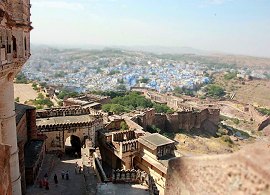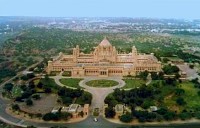 After travelling Rajasthan from the "Pink City"Jaipur, some 335 km southwest,
we arrived at Jodhpur and were quite surprised to find now a total "Blue
City" - what an exceptional sight! By tradition the blue colour indiceted,
that the city was inhabited by Brahmans, members of the supreme caste in
Hinduism. In the meantime others adopted this custom. Founded in 1459 by
Rao Jodha, the head of a former Rajput clan, the city is an island in the
depth of the Thar Desert, which is dominated by the most impressive, monumental
Mehrangarh
Fort. The fort is surrounded by a 10 km long wall with 8 gates. Palaces,
temples and other monuments of architectural and historical value bear
witness of the city's glorious past.
After travelling Rajasthan from the "Pink City"Jaipur, some 335 km southwest,
we arrived at Jodhpur and were quite surprised to find now a total "Blue
City" - what an exceptional sight! By tradition the blue colour indiceted,
that the city was inhabited by Brahmans, members of the supreme caste in
Hinduism. In the meantime others adopted this custom. Founded in 1459 by
Rao Jodha, the head of a former Rajput clan, the city is an island in the
depth of the Thar Desert, which is dominated by the most impressive, monumental
Mehrangarh
Fort. The fort is surrounded by a 10 km long wall with 8 gates. Palaces,
temples and other monuments of architectural and historical value bear
witness of the city's glorious past.
In visual range of the Mehrangarh Fort, like an oasis in the desert,
an architectural landmark is located, the Jaswant
Thada. The elaborate cenotaph from white marble and some smaller
tombs are surrounded by a beautiful garden as well as a small lake. It
is a traditional cremation place for former Jodhpur rulers and was built
in 1899 in memory of Maharaja Jaswant Singh II.
 Also
in visual range, situated on Chittar Hill, the highest point in Jodhpur,
is the
Umaid Bhawan Palace. It is named after
Maharaja Umaid Singh, grandfather of the present owner, Maharaja Gaj Singh,
and was built from 1929 - 1943. With a length of 195 meters, a width of
103 meters and 26 acres of lush gardens it is one of the largest private
residences in the world. Today the Palace is divided into three functional
parts - the residence of the erstwhile royal family, a Museum and not at
least a luxury 5 star Palace Hotel ( 94 of the 347 rooms), where one can
reside in royal rooms and live llike Maharaja and Maharani. Also
in visual range, situated on Chittar Hill, the highest point in Jodhpur,
is the
Umaid Bhawan Palace. It is named after
Maharaja Umaid Singh, grandfather of the present owner, Maharaja Gaj Singh,
and was built from 1929 - 1943. With a length of 195 meters, a width of
103 meters and 26 acres of lush gardens it is one of the largest private
residences in the world. Today the Palace is divided into three functional
parts - the residence of the erstwhile royal family, a Museum and not at
least a luxury 5 star Palace Hotel ( 94 of the 347 rooms), where one can
reside in royal rooms and live llike Maharaja and Maharani.
|